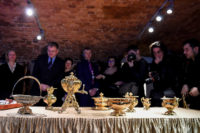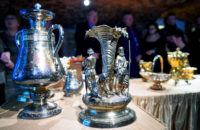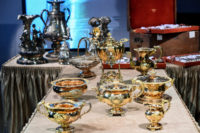 The massive collection of more than 2,000 pieces of silver secreted away in the walls of a Saint Petersburg palace and discovered during renovations in 2012 has gone on display for the first time at the Tsarskoye Selo palace museum in Pushkin. The Narshykin family had bought the palace in 1799 and lived there until 1917 when the fled the country and the Bolsheviks on the double. They left behind many valuable objects which were transferred State Hermitage Museum in 1920.
The massive collection of more than 2,000 pieces of silver secreted away in the walls of a Saint Petersburg palace and discovered during renovations in 2012 has gone on display for the first time at the Tsarskoye Selo palace museum in Pushkin. The Narshykin family had bought the palace in 1799 and lived there until 1917 when the fled the country and the Bolsheviks on the double. They left behind many valuable objects which were transferred State Hermitage Museum in 1920.
But those were just the pieces that were easy to find. Before they left Russia with their portable wealth, the family carefully wrapped their antique silver and stashed it in a hidey hole between the second and third floors of the palace. It was so effective a hiding place that it wasn’t even found when the palace was extensively renovated in the 1960s. It took a three-year project of re-engineering and restoration that began in 2009 to break through a brick wall and reveal the secret room crammed with cases full of treasure.
 Apparently some of the crew tried to take a cut of the loot, hiding it away before the construction company alerted the authorities to the find, but they weren’t up to the job the Narshykin’s had done so thoroughly before them and the police found the pieces when they searched the building.
Apparently some of the crew tried to take a cut of the loot, hiding it away before the construction company alerted the authorities to the find, but they weren’t up to the job the Narshykin’s had done so thoroughly before them and the police found the pieces when they searched the building.
The Naryshkin family was one of the most important in Tsarist Russia going back hundreds of years. It could trace its roots to the 15th century, but the family leapt to prominence when the beautiful Natalya Naryshkina (1651-1694) wed Tsar Alexis after his first wife died birthing their 13th child. Their son would become Peter the Great and she was rule as regent of Russia during his minority. Peter showered favor on his maternal family and the Naryshkin princes held high office in the government, military and court from then until the brutal end of the Russian monarchy.
In July of 1918, Colonel Kiril Mihailovich Naryshkin, adjutant to White Russian Lieutenant General Sergey Nikolaevich Rozanov, was one of the first people to enter the Ipatiev House in Ekaterinburg. Rozanov and Naryshkin broke down the defensive palisade encircling the house and went in together. There were survivors left to rescue, only evidence of the slaughter that had taken place six days earlier when the guards, knowing White Russian forces were almost upon them, executed the Tsar, his family and loyal attendants.
 While there was some talk at the time the treasure was discovered that Narshykin descendants might make an ownership claim on the silver or of the finders getting 50% of its value, but surprising nobody the collection was declared historically significant and therefore property of the state. Since then it has been studied, inventoried and conserved and is now on public view in the Catherine Palace, the main building of the Tsarskoye Selo palace museum, which is also home to the reconstructed Amber Room.
While there was some talk at the time the treasure was discovered that Narshykin descendants might make an ownership claim on the silver or of the finders getting 50% of its value, but surprising nobody the collection was declared historically significant and therefore property of the state. Since then it has been studied, inventoried and conserved and is now on public view in the Catherine Palace, the main building of the Tsarskoye Selo palace museum, which is also home to the reconstructed Amber Room.
Of all the decorative arts, I am most excited by silver. But is it known, from the silver pieces themselves or from the written records, the names of the artists and the dates when the objects were made? From the fantastic photos, it is possible that some of the objects were made in Western Europe.
Beautiful pieces, but I would like to drag your attention to the the cornucopia surrounded by three figures: what is the kneeling figure holding?
It looks like a hex or Allen key, and is that alien writing around the base of the object? Eeek!
😉
Naryshkin or Narshykin?
…Naryshkin(a) ( cf.: Ната́лья Нары́шкина)
:hattip: